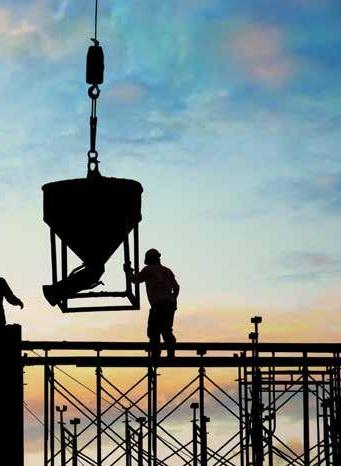
4 minute read
the Contractor faQ
By norb slowikowski
Iget asked a lot of questions in this business. you’d be surprised how much the same commonalities emerge from different parts of the country. the questions often revolve around management, leadership and skills training. Everyone wants to run their operation in the best way possible to attract the best people possible. With that in mind, here are the most frequently asked questions along with my ideas as to why they’re important for achieving productivity on the job site.
What is the main objective that a contractor should strive for in trying to improve productivity in a company?
I’d have to say, “Establish a motivational climate.” you can’t possibly motivate an individual with the same techniques that worked 10 or more years ago.
Most contractors are aware of this principle, but I will recite it anyway. I call it the “lengthening shadow approach.” as a contractor goes, so goes his organization. If a contractor is uptight, angry, hostile and disrespectful, the company will soon take on that personality. Everyone is a lengthening shadow of the leader. for that reason, a contractor should look at his foremen and superintendents as key assets to success. If a contractor is a positive and fair individual, he’ll spot that foreman who’s out of tune with the company culture and will do something about it in a positive way through a combination of straight talk and listening.
Establishing a motivational climate also requires positive reinforcement for a job well done. Rewarding top performers, involving field supervisors in the decision-making process and encouraging them to ask for help when they encounter a problem are three important ingredients to reinforcement. this requires upper management to adopt a “Let’s fix it” attitude, instead of simply blaming others when problems occur. how can an owner stay in touch with all levels of his organization and still run the business effectively? actually, it isn’t all that difficult to do. I call it the MBWa approach — Manage by Walking around. a contractor should schedule time to visit the job site and find out what’s happening on the ground. It’s just good business sense and keeps you connected to every level of the company.
But don’t restrict your fact-finding to job progress. Communicate with and listen to your people. Don’t be so certain that your foremen and supervisors will automatically tell you they are having problems. you need to encourage feedback without repercussions attached.
Let your people know that you’re interested in them and in their work. ask them if you can help in any way. Give credit where credit is due, and you’ll find that nothing is more motivating than the boss’s appreciation. It’s amazing what that does for people, and there is no cost attached to it. are there any must-dos that owners should carry out when they visit the job site?
People essentially want three things. first, they want to feel involved and be a part of the team. Second, they want sincere appreciation for a job well done. third, they want the feeling that you’ll support them when they’re facing difficulty. that when an obstacle occurs, you’ll take action to assist them or help them remove it. the old excuse that good employees don’t need positive feedback because they know when they’re doing well is archaic thinking that doesn’t match with what employees actually want.
What’s a good rule to apply when an owner spots a problem situation on the job site?
Remember, people typically don’t deliberately mess things up, so watch out for overreacting and placing blame. Instead, keep your focus on the problem and what caused it. Involve the foreman in the solution since he’s the one in charge.
When everyone focuses on a problem, a sense of achievement and belonging occurs.
What are the key elements of effective job site supervision? the jobsite supervisor must be able to identify the barriers
www.delcommunications.com

Helping your members stay connected is WHAT WE DO.
WE OFFER OUTSTANDING PERSONAL SERVICE AND QUALITY IN THE AREAS OF...
• Creative Design
• Advertising sales
• Trade Publications
• Video Production & Editing
• Qualified Sales & Editorial Team to productivity and eliminate them. they must identify the underlying causes and avoid treating only the symptoms. the first step is to specifically identify the problem. a problem that is identified is already half-solved. the second key element is listening. Remember, if someone is not listening, communication fails. the third element is motivating people. knowing what makes people tick means knowing their overall driving force. Good motivators know how to satisfy needs and wants, which can include the following: • Sincere appreciation for a job well done. • Involving them in decision-making. • Supporting them when the going gets tough. • Letting them know how they’re doing and coaching them when improvement is needed. • Giving them all the information they need to do their job effectively. for example, labor budget, scope or work, blueprints, shop drawings, addendums, copy of the contract, adequate tools and equipment, etc. • Treating them as key members of the team.
Involve your people in the process of developing an action plan to achieve desired results. achieve “buy-in” and let them help you solve problems to create a sense of teamwork so that everyone is moving toward the same goal.
Reprinted with permission from the January 2018 edition of AWCI’s Construction Dimensions magazine (www.awci.org). b







